The pre-excavation work for the South Dakota portion of the Long-Baseline Neutrino Facility reached another milestone. In June, construction workers finished securing the portal of the old tramway tunnel. The tunnel will house the conveyor system that will move about 800,000 tons of rock — excavated a mile underground to create the caverns for the Fermilab-hosted Deep Underground Neutrino Experiment — to its final resting place in the Open Cut, a former open pit mining area. The photo gallery below highlights various stages of this work.
The Homestake mining company had stopped using the tramway tunnel when it ceased mining operations in Lead, South Dakota, in 2002. Today the tunnel is part of the Sanford Underground Research Facility. The LBNF team is now in the process of rehabilitating the tunnel to get it ready for the installation of a conveyor system that will run from the Ross Shaft, exit through the rebuilt portal and extend to the Open Cut (see graphic). When the work is complete, the tunnel will house about 2,300 feet of the 4,250-foot-long conveyor system.
Click on the magnifying glass in the photo gallery below to view photos in full.
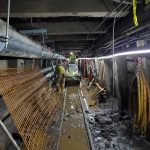
LBNF excavation - summer 2019
Construction workers are currently rehabilitating the tramway tunnel at Sanford Lab. The goal is to prepare it for the installation of a 2,300-foot-long section of a conveyor system that will move rock from the mile-deep Ross Shaft to the Open Cut for the LBNF construction. Credit: Fermilab
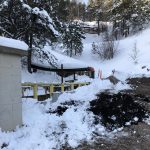
LBNF excavation - summer 2019
Where is the portal of the old tramway tunnel? In April, the portal was buried under snow. Credit: Fermilab
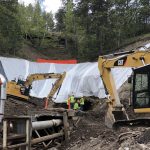
LBNF excavation - summer 2019
In May, work was in full swing to expose and remove the existing timber structure at the portal. It will be replaced with a concrete enclosure. Credit: Fermilab
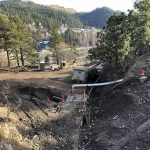
LBNF excavation - summer 2019
This photo shows the construction site from above the old portal. When complete in 2020, the conveyor system will extend down the hill and begin moving rock to the Open Cut. Credit: Fermilab
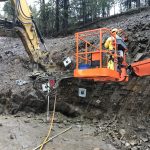
LBNF excavation - summer 2019
Once the soil and old structures were removed in May, workers started securing the rock face above the portal with rock bolts. Credit: Fermilab
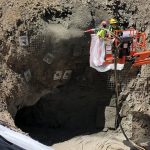
LBNF excavation - summer 2019
In June, construction workers applied shotcrete on the rock surrounding the portal. Credit: Fermilab
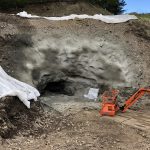
LBNF excavation - summer 2019
Done: the rebuilt portal of the tramway tunnel. A new concrete enclosure will extend the tunnel approximately 80 feet beyond this point, which will allow for the restoration of a roadway above the tunnel. When complete, the conveyor system will exit the tramway tunnel at the end of the new enclosure and move rock from the Ross Shaft to the Open Cut. Credit: Fermilab
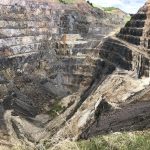
LBNF excavation - summer 2019
For the LBNF project, about 800,000 tons of rock will be transported to this former open pit mining area in Lead, South Dakota, known as the Open Cut. The excavated rock will fill less than one percent of the Open Cut. Credit: Fermilab

LBNF excavation - summer 2019
This graphic illustrates how the conveyor system will transport rock from the Ross Shaft through the tramway tunnel to the Open Cut. Credit: Fermilab
December 19, 2025
Gray Putnam, James Mott, Lauren Yates and Chris Jensen are this year’s recipients of the URA Honorary Awards. The awards are presented each year to recognize significant contributions to research at Fermilab.
December 17, 2025
Throughout this year, Fermilab’s dedicated scientists, engineers, technicians and operations staff came together to drive discoveries, advance American innovation and prepare the lab for a bright future.
September 19, 2025
In its quest to understand why matter exists, the flagship neutrino experiment hosted by Fermilab is constructing an enormous next-generation liquid-argon-based detector a mile underground. The Deep Underground Neutrino Experiment is building on the successes of previous liquid-argon experiments, promising measurements of unprecedented precision over a wide range of energies that will bring significant new insights into the nature of the universe.












